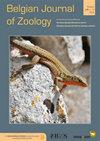Thermal effect on larval development of the European stag beetle, Lucanus cervus
IF 1.1
4区 生物学
Q2 ZOOLOGY
引用次数: 1
Abstract
Conservation of the threatened and protected European stag beetle (Lucanus cervus) mainly focuses on the availability of dead wood as larval habitat. However, as the larval ecology of this species remains poorly studied, less attention has been given to other habitat requirements such as ambient temperatures for the development of the larvae. To design proper guidelines for the preservation of this iconic species, the growth of stag beetle larvae is compared between outdoor containers under a warm sunny and those in a cold shady treatment. Populations originated from the Veluwe (Netherlands) and Colchester (United Kingdom). The shady microclimate led to lower temperatures, which resulted in higher larval weights before molting and an additional year to complete larval development for a part of the population. However, weights were lower than in the warm microclimate when comparing larvae from the same age. This is explained by the longer development time for the different stages. Finally, we found higher larval weights for larvae originating from the Veluwe (Netherlands) compared with larvae from Colchester (UK). We conclude that larvae of L. cervus can cope with shady, colder microclimates. Larval development time in general takes two to three years and depends on temperature. Larvae grow mainly in the warm season while weight remains constant, or even decreases, during the cold season with an approximate threshold between 10 to 15 C.温度对欧洲鹿甲幼虫发育的影响
欧洲鹿角甲虫(Lucanus cervus)的濒危和受保护物种的保护主要集中在可获得的枯木作为其幼虫栖息地。然而,由于该物种的幼虫生态学研究仍然很少,因此对幼虫发育的环境温度等其他栖息地要求的关注较少。为了设计适当的保护这一标志性物种的指导方针,将鹿角甲虫幼虫的生长在温暖阳光下的室外容器和寒冷阴凉处理下的室外容器中进行比较。种群起源于Veluwe(荷兰)和Colchester(英国)。阴凉的小气候导致了较低的温度,这导致了蜕皮前的幼虫体重增加,并使一部分种群多了一年的时间来完成幼虫的发育。但同龄期幼虫的体重低于温暖小气候条件下的体重。这是因为不同阶段的开发时间较长。最后,我们发现来自荷兰Veluwe的幼虫比来自英国Colchester的幼虫重。我们得出结论,鹿乳杆菌的幼虫可以适应阴凉,寒冷的小气候。幼虫的发育时间一般为两到三年,取决于温度。幼虫主要在温暖季节生长,而在寒冷季节体重保持不变,甚至减少,大约在10至15℃之间。
本文章由计算机程序翻译,如有差异,请以英文原文为准。
求助全文
约1分钟内获得全文
求助全文
来源期刊

Belgian Journal of Zoology
生物-动物学
CiteScore
1.90
自引率
0.00%
发文量
10
审稿时长
>12 weeks
期刊介绍:
The Belgian Journal of Zoology is an open access journal publishing high-quality research papers in English that are original, of broad interest and hypothesis-driven. Manuscripts on all aspects of zoology are considered, including anatomy, behaviour, developmental biology, ecology, evolution, genetics, genomics and physiology. Manuscripts on veterinary topics are outside of the journal’s scope. The Belgian Journal of Zoology also welcomes reviews, especially from complex or poorly understood research fields in zoology. The Belgian Journal of Zoology does no longer publish purely taxonomic papers. Surveys and reports on novel or invasive animal species for Belgium are considered only if sufficient new biological or biogeographic information is included.
 求助内容:
求助内容: 应助结果提醒方式:
应助结果提醒方式:


